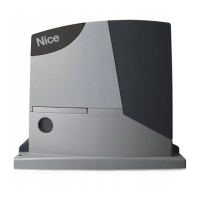EN
5 – English
4 s
x 3
3 s
4.7.1 - Memorization mode I
TABLE 9 - To memorize a trasmitter in mode I
01. Pressthebuttononthereceiverandholditdown(approx.4s)
02. Release the button when the radio LED on the control unit lights up
03. Within10s,pressanybuttonontheradiotransmittertobememorizedandholditdownforatleast3s
04. Ifthememorizationprocedureissuccessful,theLEDonthereceiverwillash3times
Note – If there are other transmitters to be memorized, repeat step 3 within the next 10s.
If no new codes are received within 10 seconds, the memorisation phase terminates.
4.7.2 - Memorization mode II
TABLE 10 - To memorize the botton of trasmitter in mode II
01. Press the radio button on the control unit as many times as the number corresponding to the desired command,
according to table 5
02. MakesurethattheradioLEDonthecontrolunitmakesasmanyashesasthenumbercorrespondingtothe
selected command
03. Within10s,pressanybuttonontheradiotransmittertobememorizedandholditdownforatleast3s
04. Ifthememorizationprocedureissuccessful,theLEDonthereceiverwillash3times
Note – If there are other transmitters to be memorized for the same command, repeat step 3 within the next 10s.
If no new codes are received within 10 seconds, the memorisation phase terminates.
4.7 - Memorization of radio transmitters
Each radio transmitter is recognised by the radio receiver by means of a “code”
which differs from that of any other transmitter. A “memorisation” phase must
therefore be performed in order to allow the receiver to recognise each single
transmitter. Transmitters can be memorised in 2 ways:
Mode I:inthismodethefunctionofthetransmitterbuttonsisxedandeach
button corresponds to the command in the control unit shown in Table 5. A
single stage is carried out for each transmitter, during which all the transmitter
buttons are memorised. It does not matter which button is pressed during this
stage and only one place in the memory is used. A transmitter can normally
only control a single automation in Mode I.
Mode II: in this mode, each transmitter button can be associated with one of
the 4 possible control unit commands shown in Table 6. Only one button is
memorised for each stage, namely the one which was pressed during memori-
sation. One place in the memory is occupied for each button memorised.
In Mode II; different buttons on the same transmitter can be used in order to
give the same automation more than one command or to control more than
4.6 - Radio receiver
A radio receiver is incorporated in the control unit for remote control of Road400,
operating at a frequency of 433.92 MHz and compatible with the transmitter
types indicated in Table 4:
TABLE 4 - Transmitters
FLOR FLO1R-S - FLO2R-S - FLO4R-S
FLO1RE - FLO2RE - FLO4RE
INTI1 INTI2
ON1E - ON2E - ON4E - ON9E
VERYVR
Coding digital Rolling code
with 52 Bit code, FLOR type
FLO FLO1-FLO2-FLO4-VERYVE Codingdigitalxedcodewith
12 Bit code, FLO type
SMILO SM2 - SM4 Coding digital Rolling code
with 64 Bit code, SMILO type
Becausethetypeofencodingisdifferent,thersttransmitterintroduceddeter-
minesthetypeoftransmitterthatcanbeintroducedafterwards.Upto160
transmitters can be memorised.
T1 button “Step-by-step” command
T2 button “Pedestrian gate” command
T3 button “Open” command
T4 button “Close” command
Nota – single-channel transmitters only have a T1 button,
two channel transmitters only have T1 and T2 buttons.
TABLE 5 - Memorization Mode I
1 “Step-by-step” command
2 “Pedestrian gate” command
3 “Open” command
4 “Close” command
TABLE 6 - Commands available in Mode II
T1 button
“Open” command
Automation A
T2 button
“Close” command
Automation A
T3 button
“Pedestrian gate” command
Automation A
T4
button
“Pedestrian gate” command
Automation A
TABLE 7 - 1° example of memorization in Mode II
T1 button
“Open” command
Automation A
T2 button
“Close” command
Automation A
T3 button
“Step-by-step” command
Automation B
T4
button
“Step-by-step” command
Automation C
TABLE 8 - 2° example of memorization in Mode II
1....4
3 s
x 3
1....4
one automation. For example, in Table 7, only automation “A” is controlled, and
the T3 and T4 buttons are associated with the same command. Alternatively,
three automations are controlled in the example shown in Table 8, namely “A”
(buttonsT1andT2),“B”(buttonT3)and“C”(buttonT4).
Since the memorization procedures are timed (10s), you must read
the instructions in the following paragraphs before you proceed with
their execution.

